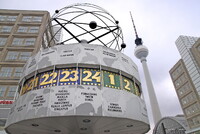| dc.coverage.spatial | Site: Berlin, Berlin (state), Germany | en_US |
| dc.coverage.temporal | 1969 (creation) | en_US |
| dc.creator | John, Erich | en_US |
| dc.date | 1969 | en_US |
| dc.date.accessioned | 2016-06-07T15:22:41Z | |
| dc.date.available | 2016-06-07T15:22:41Z | |
| dc.date.issued | 1969 | en_US |
| dc.identifier | 262846 | en_US |
| dc.identifier.other | archrefid: 3344 | en_US |
| dc.identifier.uri | http://hdl.handle.net/1721.3/178904 | |
| dc.description | Detail, nighttime color-coded hours in rings for the hour, city and time zone (Berlin Fernsehturm in the background); A world clock is a clock which displays the time for various cities around the world; this clock displays 148 cities on one ring of the metal cylinder. The cylinder has 3 rings; an hour ring rotates between the 24 world time zones shown. On top is a simplified representation of the solar system with planets (spheres) and their paths shown with steel circles, which rotates once a minute. The 16-ton clock was installed in 1969 when the Alexanderplatz re-design was almost complete (Erich John was part of the design team). The metal sculptor Hans-Joachim Kunsch helped construct it. Since July 2015, the Urania World Clock is a German listed building. Source: Wikipedia; http://en.wikipedia.org/wiki/Main_Page (accessed 8/5/2015) | en_US |
| dc.format.medium | stone; aluminum; steel | en_US |
| dc.rights | © Scott Gilchrist, Archivision, Inc. | en_US |
| dc.subject | contemporary (1960 to present) | en_US |
| dc.subject | timekeeping | en_US |
| dc.subject | Timekeeping | en_US |
| dc.subject | Twentieth century | en_US |
| dc.title | Urania World Clock | en_US |
| dc.title.alternative | Urania-Weltzeituhr | en_US |
| dc.type | image | en_US |
| dc.rights.access | Licensed for educational and research use by the MIT community only | en_US |
| dc.identifier.vendorcode | 1A1-JOHN-WC-A03 | en_US |
| vra.culturalContext | German | en_US |
| vra.technique | metalworking | en_US |
| vra.worktype | electronic clock | en_US |
| dc.contributor.display | Erich John (German designer, born 1932) | en_US |

